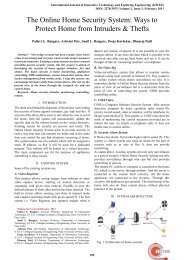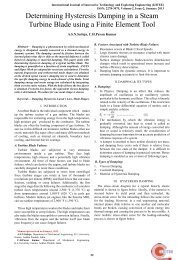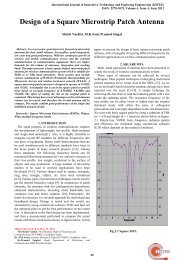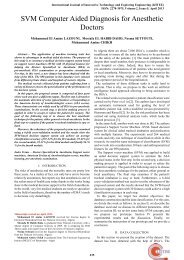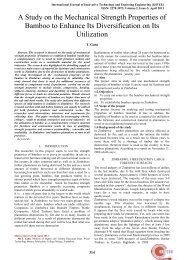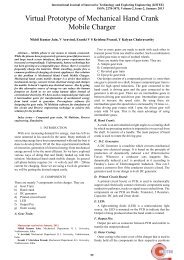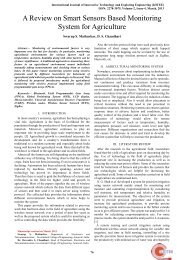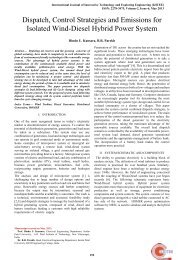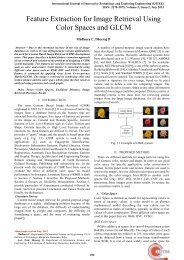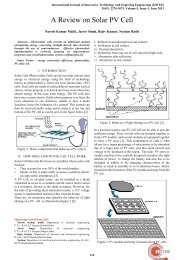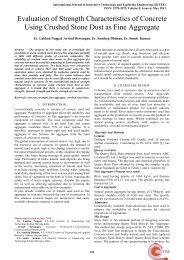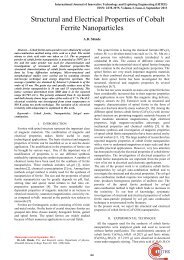Effect of Pressure Angle on Transmission Efficiency of Helical Gears
Effect of Pressure Angle on Transmission Efficiency of Helical Gears
Effect of Pressure Angle on Transmission Efficiency of Helical Gears
Create successful ePaper yourself
Turn your PDF publications into a flip-book with our unique Google optimized e-Paper software.
<strong>Efficiency</strong><br />
<strong>Efficiency</strong><br />
Internati<strong>on</strong>al Journal <str<strong>on</strong>g>of</str<strong>on</strong>g> Innovative Technology and Exploring Engineering (IJITEE)<br />
ISSN: 2278-3075, Volume-3, Issue-2, July 2013<br />
Ψ 20.000 25.000 15.000<br />
da<br />
38.<br />
598<br />
68.<br />
972<br />
37.<br />
562<br />
70.<br />
427<br />
37.53<br />
4 70.455<br />
df<br />
30.<br />
028<br />
60.<br />
402<br />
28.<br />
573<br />
61.<br />
438<br />
28.54<br />
5 61.466<br />
dw<br />
33.<br />
333<br />
66.<br />
667<br />
33.<br />
333<br />
66.<br />
667<br />
33.33<br />
3 66.667<br />
Table no 1(c) Test matrix showing dimensi<strong>on</strong>s <str<strong>on</strong>g>of</str<strong>on</strong>g> helical<br />
gear pair for pressure angle 25°<br />
Abbr<br />
RH LH RH LH RH LH<br />
.<br />
z<br />
16.0<br />
00<br />
22.0<br />
00<br />
32.0<br />
00<br />
22.0<br />
00<br />
15.0<br />
00<br />
22.0<br />
00<br />
30.0<br />
00<br />
22.0<br />
00<br />
15.00<br />
0<br />
22.00<br />
0<br />
b<br />
mn 2.000 2.000 2.000<br />
p 6.283 6.283 6.283<br />
aw 50.000 50.000 50.000<br />
Φ 25 25 25<br />
Ψ 15.000 20.000 25.000<br />
da<br />
df<br />
dw<br />
37.5<br />
35<br />
28.5<br />
43<br />
33.3<br />
33<br />
70.4<br />
57<br />
61.4<br />
65<br />
66.6<br />
67<br />
37.3<br />
09<br />
28.3<br />
96<br />
32.6<br />
09<br />
70.6<br />
04<br />
61.6<br />
91<br />
67.3<br />
91<br />
37.56<br />
2<br />
28.57<br />
1<br />
33.33<br />
3<br />
V. EXPERIMENTAL FACILITIES AVAILABLE<br />
30.00<br />
0<br />
22.00<br />
0<br />
70.42<br />
9<br />
61.43<br />
8<br />
66.66<br />
7<br />
The test rig is manufactured by me. The machine c<strong>on</strong>sists<br />
<str<strong>on</strong>g>of</str<strong>on</strong>g> a pair <str<strong>on</strong>g>of</str<strong>on</strong>g> opposing, identical gear boxes, each c<strong>on</strong>taining a<br />
pair <str<strong>on</strong>g>of</str<strong>on</strong>g> helical gears with gear ratio 2, supported by rigid<br />
shafts mounted <strong>on</strong> two pairs <str<strong>on</strong>g>of</str<strong>on</strong>g> bearings. They are labeled as<br />
‗Test Gearbox‘ and ‗Reacti<strong>on</strong> Gearbox‘ for the purpose <str<strong>on</strong>g>of</str<strong>on</strong>g><br />
distinguishing them while they are identical in every aspect.<br />
Each gear is held in place between two bearings, a<br />
deep-groove ball bearing <strong>on</strong> the outside (SKF Model 6206)<br />
and a four-point angular c<strong>on</strong>tact ball bearing (SKF Model QJ<br />
206 MA) <strong>on</strong> the inside. The deep-groove ball bearing is not<br />
axially loaded (allowed to float axially), allowing all <str<strong>on</strong>g>of</str<strong>on</strong>g> the<br />
axial load to be carried by the four-point angular c<strong>on</strong>tact ball<br />
bearing. In this arrangement, the bearings are not required to<br />
be preloaded. This avoids repeatability problems associated<br />
with setting the correct amount <str<strong>on</strong>g>of</str<strong>on</strong>g> preload for each test as well<br />
as changes in preload due to temperature effects that would be<br />
detrimental to the fidelity <str<strong>on</strong>g>of</str<strong>on</strong>g> the measurements. The<br />
gearboxes are powered by a variable speed AC motor<br />
c<strong>on</strong>nected to a high-speed spindle. The c<strong>on</strong>necti<strong>on</strong> is through<br />
a 3:1 ratio belt drive. The high speed spindle is c<strong>on</strong>nected to<br />
the splined input shaft <str<strong>on</strong>g>of</str<strong>on</strong>g> the reacti<strong>on</strong> gearbox through a flat<br />
belt pulley. The torque loss in the system T L is measured using<br />
a high-precisi<strong>on</strong>, n<strong>on</strong>-c<strong>on</strong>tact type torque-meter (Lebow<br />
model TMS 9000) that is mounted <strong>on</strong> the output shaft <str<strong>on</strong>g>of</str<strong>on</strong>g><br />
reacti<strong>on</strong> gearbox.. The lubricati<strong>on</strong> systems and parameters <str<strong>on</strong>g>of</str<strong>on</strong>g><br />
the test and reacti<strong>on</strong> gearboxes are kept identical to ensure the<br />
same thermal c<strong>on</strong>diti<strong>on</strong>s for both gearboxes. The maximum<br />
operating speed that the test machine can reach is 400 rpm,<br />
with a fixed center distance <str<strong>on</strong>g>of</str<strong>on</strong>g> 50 mm and fixed face width <str<strong>on</strong>g>of</str<strong>on</strong>g><br />
22 mm.<br />
Fig.1 Experimental set up<br />
VI. RESULT AND DISCUSSION<br />
The influence <str<strong>on</strong>g>of</str<strong>on</strong>g> the basic design parameters such as<br />
pressure angle as well as the rotati<strong>on</strong>al speed and input torque<br />
<strong>on</strong> load independent (spin) power losses <str<strong>on</strong>g>of</str<strong>on</strong>g> helical gear pairs<br />
are studied experimentally in this chapter. Applying the test<br />
methodology proposed in the previous chapter, the<br />
experiments defined in the test matrix <str<strong>on</strong>g>of</str<strong>on</strong>g> Table 5(a), 5(b) and<br />
5(c) are executed under both loaded and unloaded c<strong>on</strong>diti<strong>on</strong>s<br />
in order to calculate total gear pair power loss.<br />
Fig. 2 to 10 shows the variati<strong>on</strong> <str<strong>on</strong>g>of</str<strong>on</strong>g> efficiency against the<br />
pressure angle. Fig 2, 3 and 4 shows the variati<strong>on</strong> for helix<br />
angle 25° at different speeds. Fig 2 and 3 shows nearly linear<br />
loss in efficiency for decreasing pressure angles for all torque<br />
values.<br />
Fig 5, 6 and 7 shows the variati<strong>on</strong> <str<strong>on</strong>g>of</str<strong>on</strong>g> efficiency against<br />
pressure angle for helix angle 20° and for different speeds. As<br />
the pressure angle decreases the efficiency decreases for all<br />
torques and speeds values.<br />
Load Dependant Losses<br />
93<br />
92<br />
91<br />
90<br />
89<br />
88<br />
87<br />
25 22.5 20<br />
<str<strong>on</strong>g>Pressure</str<strong>on</strong>g> <str<strong>on</strong>g>Angle</str<strong>on</strong>g><br />
2.5<br />
5<br />
7.5<br />
Fig. 2 <str<strong>on</strong>g>Pressure</str<strong>on</strong>g> angle vs. <strong>Efficiency</strong> Helix angle – 25,<br />
Speed 2500 rpm<br />
Load Dependant Losses<br />
96<br />
94<br />
92<br />
90<br />
88<br />
25 22.5 20<br />
<str<strong>on</strong>g>Pressure</str<strong>on</strong>g> <str<strong>on</strong>g>Angle</str<strong>on</strong>g><br />
10<br />
2.5<br />
5<br />
7.5<br />
Fig. 3 <str<strong>on</strong>g>Pressure</str<strong>on</strong>g> angle vs. <strong>Efficiency</strong> Helix angle – 25,<br />
Speed 3400 rpm<br />
10<br />
44



